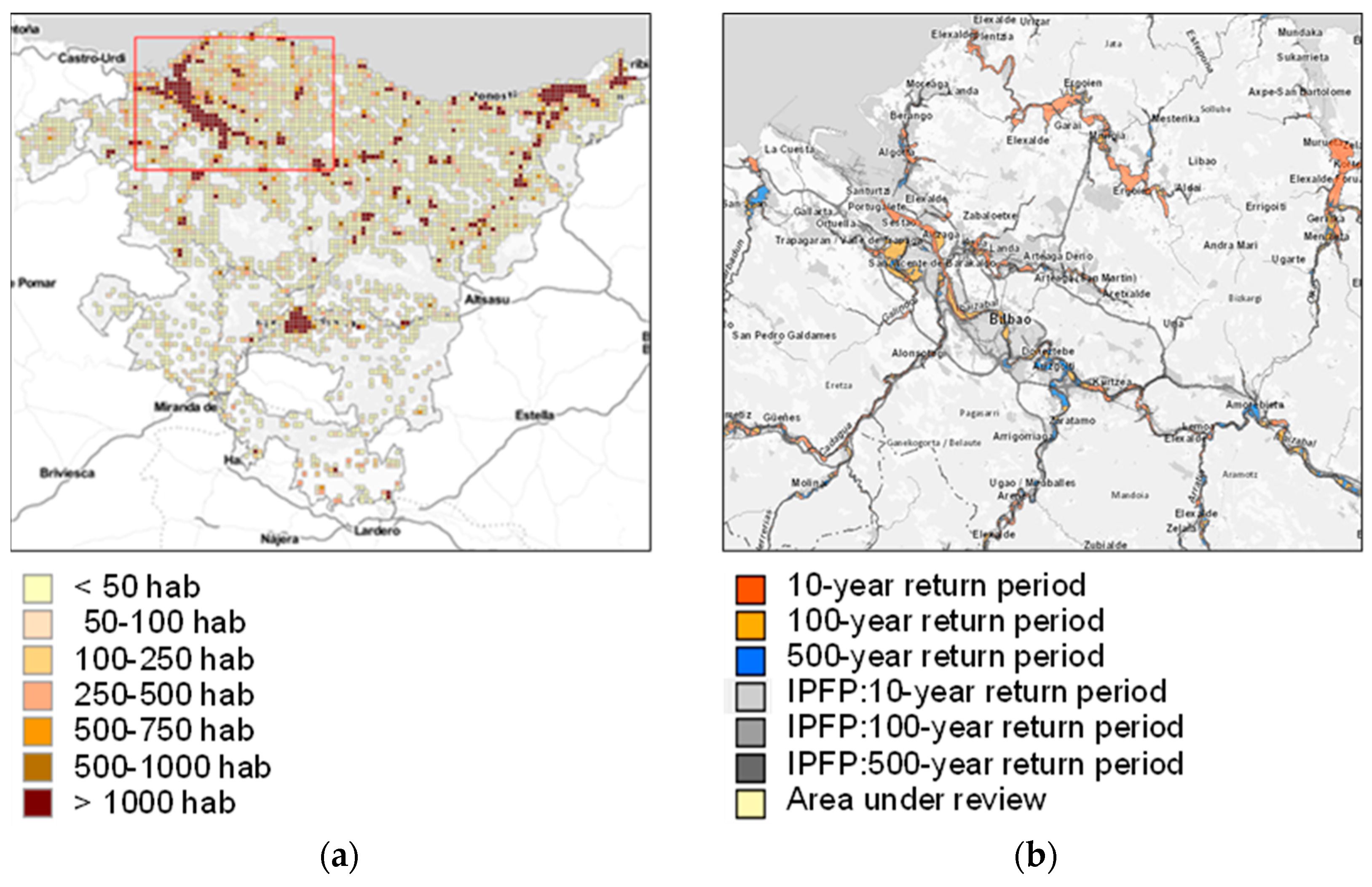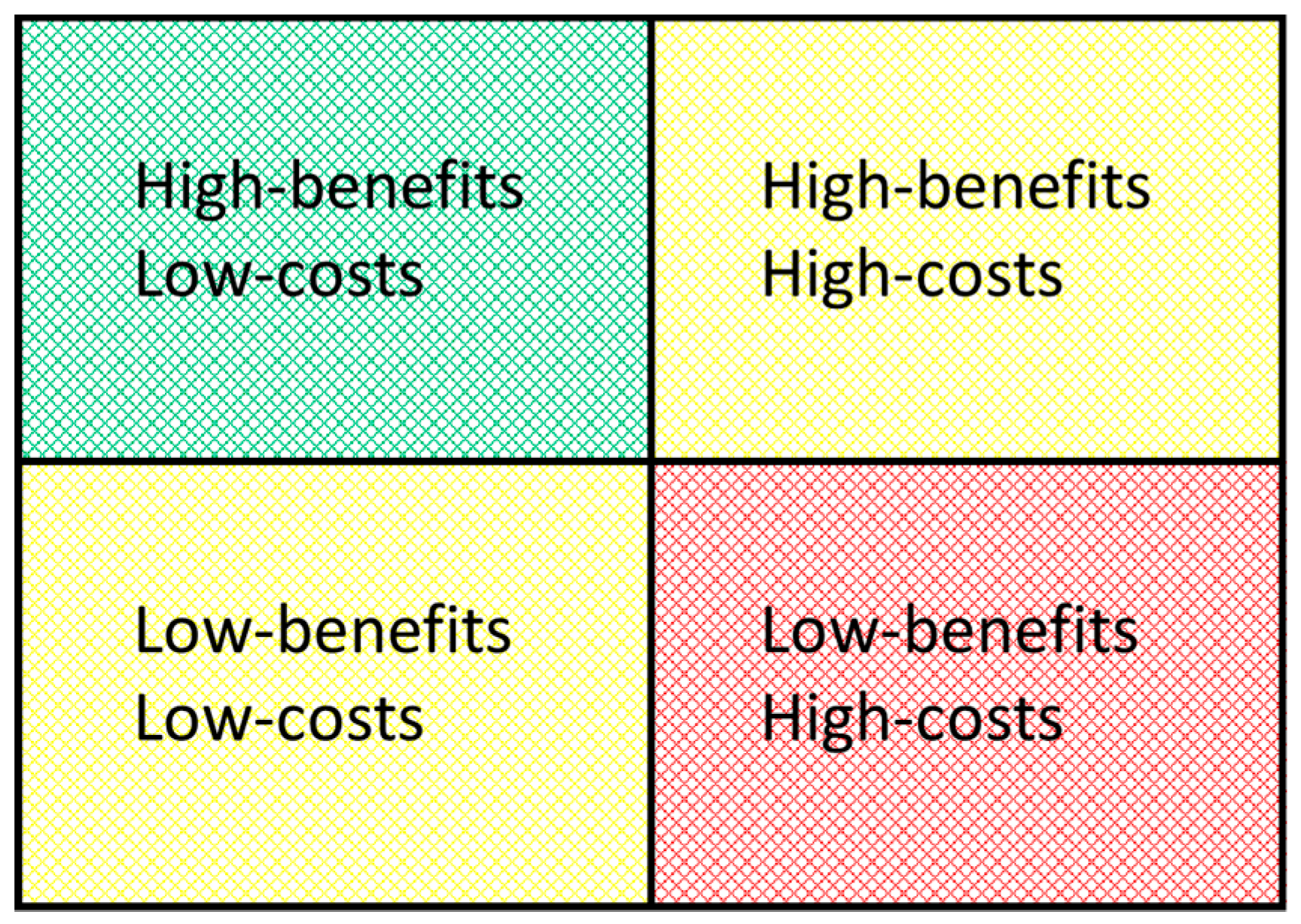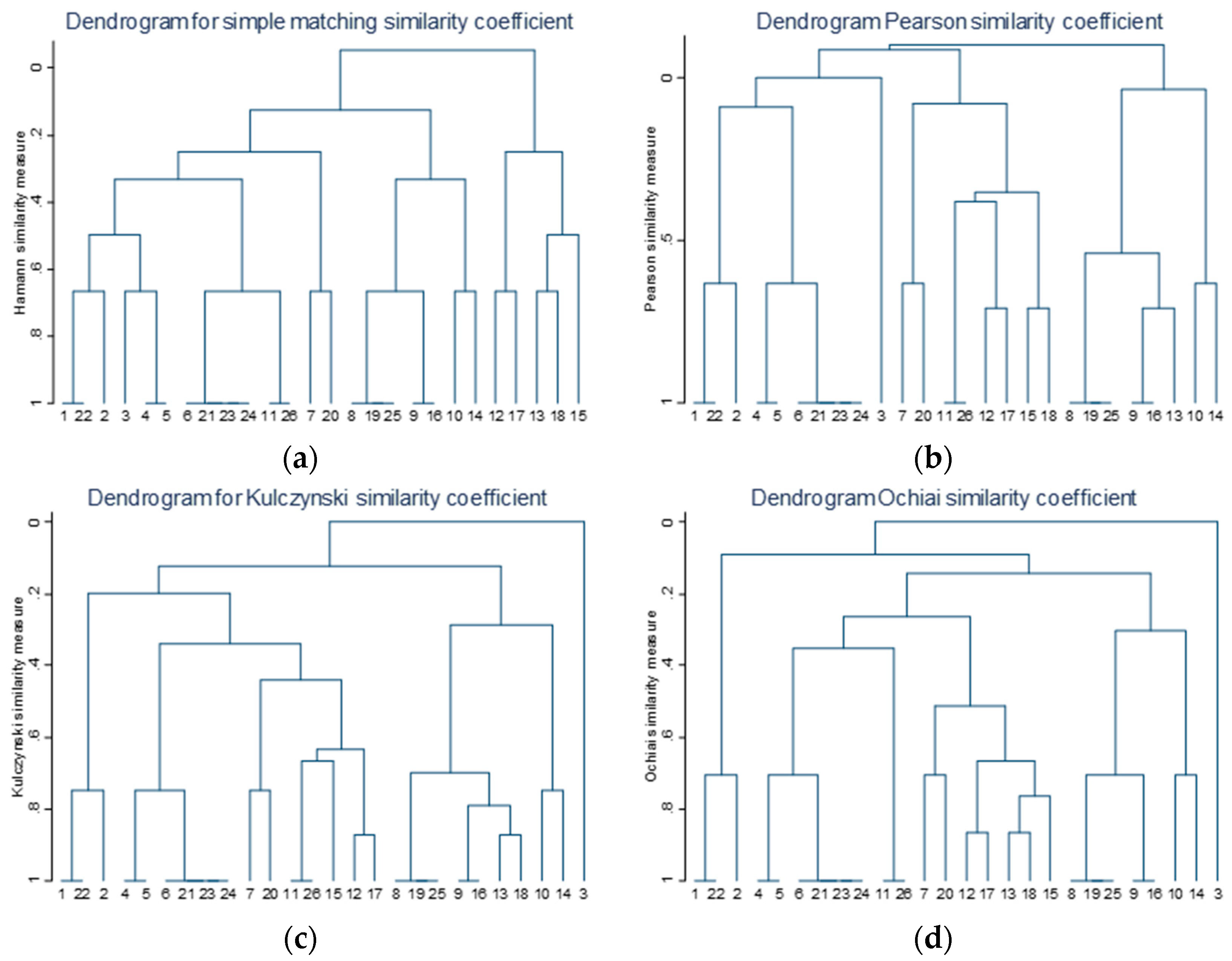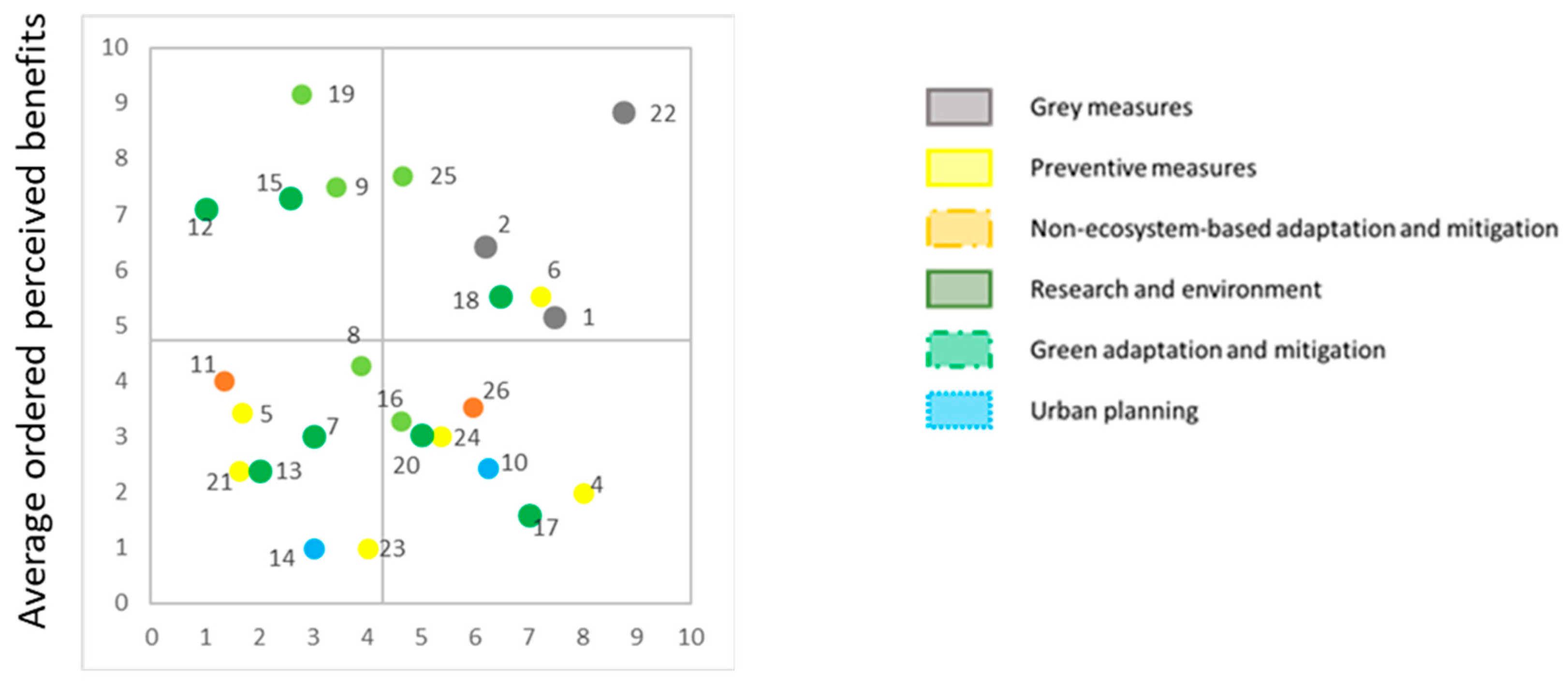Insights on Urban and Periurban Adaptation Strategies Based on Stakeholders’ Perceptions on Hard and Soft Responses to Climate Change
Abstract
1. Introduction
2. Materials and Methods
2.1. Case Study Context
2.2. Participatory Process to Extract Local Adaptation Strategies
2.3. Cluster Analysis
| Observation | |||
| 1 | 0 | ||
| Observ. | 1 | ||
| 0 | |||
2.4. A Bootstrap Approach for Simulating Perceived Cumulative Distribution Functions
2.5. Efficiency in Terms of Benefit-Cost Perceptions
3. Results
3.1. Overview of Contributions and Perceptions
3.2. Clustering the Measures
3.3. Measuring Consensus among Participants’ Views
3.4. Assessing Efficiency According to Stakeholders’ Perceptions
4. Discussion and Conclusions
Author Contributions
Funding
Acknowledgments
Conflicts of Interest
References
- IPCC. Climate Change 2014: Synthesis Report; Contribution of Working Groups I, II and III to the Fifth Assessment Report of the Intergovernmental Panel on Climate Change; Pachauri, R.K., Meyer, L.A., Eds.; IPCC: Geneva, Switzerland, 2014. [Google Scholar]
- Few, R.; Brown, K.; Tompkins, E.L. Public participation and climate change adaptation: Avoiding the illusion of inclusion. Clim. Policy 2007, 7, 46–59. [Google Scholar] [CrossRef]
- Chess, C.; Purcell, K. Public participation and the environment: Do we know what works? Environ. Sci. Technol. 1999, 33, 2685–2692. [Google Scholar] [CrossRef]
- UNFCCC. United Nations Framework Convention on Climate Change; United Nations: New York, NY, USA, 1992. [Google Scholar]
- C40 Cities. Climate Change Adaptation in Delta Cities; C40 Cities: London, UK, 2016. [Google Scholar]
- Rotter, M.; Hoffmann, E.; Hirschfeld, J.; Schröder, A.; Mohaupt, F.; Schäfer, L. Stakeholder Participation in Adaptation of Climate Change; Umwelt Bundesamt: Berlin, Germany, 2013. [Google Scholar]
- PlaNYC. A Stronger, More Resilient New York. The City of New York: New York, NY, USA. Available online: http://s-media.nyc.gov/agencies/sirr/SIRR_singles_Lo_res.pdf (accessed on 20 December 2018).
- Lynam, T.; de Jong, W.; Sheil, D.; Kusumanto, T.; Evans, K. A review of tools for incorporating community knowledge, preferences, and values into decision making in natural resources management. Ecol. Soc. 2007, 12, 5. [Google Scholar] [CrossRef]
- Moran, S.; Perreault, M.; Smardon, R. Finding our way: A case study of urban waterway restoration and participatory process. Landsc. Urban Plan. 2016. [Google Scholar] [CrossRef]
- Schunn, C.D.; Crowley, K.; Okada, T. The growth of multidisciplinarity in the cognitive science society. Cogn. Sci. 1998, 22, 107–130. [Google Scholar] [CrossRef]
- Uiterkamp, A.J.M.S.; Vlek, C. Practice and Outcomes of Multidisciplinary Research for Environmental Sustainability. J. Soc. Issues 2007, 63, 175–197. [Google Scholar] [CrossRef]
- Reed, M.S. Stakeholder participation for environmental management: A literature review. Biol. Conserv. 2008, 141, 2417–2431. [Google Scholar] [CrossRef]
- Vignola, R.; Locatelli, B.; Martinez, C.; Imbach, P. Ecosystem-based adaptation to climate change: What role for policy-makers, society and scientists? Mitig. Adapt. Strateg. Glob. Chang. 2009, 14, 691–696. [Google Scholar] [CrossRef]
- Adger, W.N.; Arnell, N.W.; Tompkins, E.L. Successful adaptation to climate change across scales. Glob. Environ. Chang. 2005, 15, 77–86. [Google Scholar] [CrossRef]
- Osés Eraso, N. Costes del cambio climático en el País Vasco por riesgo de inundación. Ekonomiaz 2009, 71, 62–83. [Google Scholar]
- Foudi, S.; Osés-Eraso, N.; Tamayo, I. Integrated spatial flood risk assessment: The case of Zaragoza. Land Use Policy 2015, 42, 278–292. [Google Scholar] [CrossRef]
- Osés, N.; Foudi, S.; Galarraga, I. Análisis del Impacto Socio Económico del Daño por Inundación en la Ría de Nervión; Basque Centre for Climate Change (BC3): Bilbao, Spain, 2012. [Google Scholar]
- Rodríguez Díaz, J.A.; Weatherhead, E.K.; Knox, J.W.; Camacho, E. Climate change impacts on irrigation water requirements in the Guadalquivir river basin in Spain. Reg. Environ. Chang. 2007, 7, 149–159. [Google Scholar] [CrossRef]
- EUSTAT. Población de la C.A. de Euskadi por Ámbitos Territoriales, Según Sexo y densidad de Población. 1 January 2017. Available online: http://es.eustat.eus/elementos/ele0011400/Poblacion_de_la_CA_de_Euskadi_por_ambitos_territoriales_segun_sexo_y_densidad_de_poblacion/tbl0011429_c.html (accessed on 22 December 2017).
- Eusko Jaurlaritza/Gobierno Vasco. geoEuskadi. Eusko Jaurlaritza/Gobierno Vasco: Vitoria-Gasteiz, Spain, 2018.
- Aranda, C.; Eritja, R.; Roiz, D. First record and establishment of the mosquito Aedes albopictus in Spain. Med. Vet. Entomol. 2006, 20, 150–152. [Google Scholar] [CrossRef]
- Purse, B.V.; Mellor, P.S.; Rogers, D.J.; Samuel, A.R.; Mertens, P.P.C.; Baylis, M. Opinion: Climate change and the recent emergence of bluetongue in Europe. Nat. Rev. Microbiol. 2005, 3, 171–181. [Google Scholar] [CrossRef]
- Barandika, J.F.; Hurtado, A.; García-Sanmartín, J.; Juste, R.A.; Anda, P.; García-Pérez, A.L. Prevalence of Tick-Borne Zoonotic Bacteria in Questing Adult Ticks from Northern Spain. Vector-Borne Zoonotic Dis. 2008, 8, 829–836. [Google Scholar] [CrossRef] [PubMed]
- Benedict, M.Q.; Levine, R.S.; Hawley, W.A.; Lounibos, L.P. Spread of The Tiger: Global Risk of Invasion by The Mosquito Aedes albopictus. Vector-Borne Zoonotic Dis. 2007, 7, 76–85. [Google Scholar] [CrossRef] [PubMed]
- Blondet, M.; de Koning, J.; Borrass, L.; Ferranti, F.; Geitzenauer, M.; Weiss, G.; Turnhout, E.; Winkel, G. Participation in the implementation of Natura 2000: A comparative study of six EU member states. Land Use Policy 2017, 66, 346–355. [Google Scholar] [CrossRef]
- National Research Council. Public Participation in Environmental Assessment and Decision Making; Dietz, T., Stern, P.C., Eds.; The National Academies Press: Washington, DC, USA, 2008. [Google Scholar]
- Umpleby, S. Second-order science: Logic, strategies, Methods. Constr. Found. 2014, 11, 455–456. [Google Scholar]
- Fazey, I.; Schäpke, N.; Caniglia, G.; Patterson, J.; Hultman, J.; van Mierlo, B.; Säwe, F.; Wiek, A.; Wittmayer, J.; Aldunce, P.; et al. Ten essentials for action-oriented and second order energy transitions, transformations and climate change research. Energy Res. Soc. Sci. 2018, 40, 54–70. [Google Scholar] [CrossRef]
- Phi, H.L.; Hermans, L.M.; Douven, W.J.A.M.; Van Halsema, G.E.; Khan, M.F. A framework to assess plan implementation maturity with an application to flood management in Vietnam. Water Int. 2015, 40, 984–1003. [Google Scholar] [CrossRef]
- Raymond, C.M.; Bryan, B.A.; MacDonald, D.H.; Cast, A.; Strathearn, S.; Grandgirard, A.; Kalivas, T. Mapping community values for natural capital and ecosystem services. Ecol. Econ. 2009, 68, 1301–1315. [Google Scholar] [CrossRef]
- Sokal, R.R.; Michener, C.D. A Statistical Method for Evaluating Systematic Relationships. Univ. Kansas Sci. Bull. 1958, 38, 1409–1438. [Google Scholar]
- Ochiai, A. Zoogeographical Studies on the Soleoid Fishes Found in Japan and its Neighbouring Regions-III. Nippon Suisan Gakkaishi 1957, 22, 531–535. [Google Scholar] [CrossRef]
- Yin, Y.; Yasuda, K. Similarity coefficient methods applied to the cell formation problem: A taxonomy and review. Int. J. Prod. Econ. 2006, 101, 329–352. [Google Scholar] [CrossRef]
- Lahiri, S.N. Resampling Methods for Dependent Data; Springer: New York, NY, USA, 2013. [Google Scholar]
- Efron, B. The 1977 rietz lecture bootstrap methods: Another look at the jackknife. Ann. Stat. 1979, 7, 1–26. [Google Scholar] [CrossRef]
- Webster, M. Communicating Climate Change Uncertainty to Policy-Makers and the Public. Clim. Chang. 2003, 61, 1–8. [Google Scholar] [CrossRef]
- Lempert, R.J.; Schlesinger, M.E.; Bankes, S.C. When we don’t know the costs or the benefits: Adaptive strategies for abating climate change. Clim. Chang. 1996, 33, 235–274. [Google Scholar] [CrossRef]
- Secretariat of the Convention on Biological Diversity. Connecting Biodiversity and Climate Change Mitigation and Adaptation: Report of the Second Ad Hoc Technical Expert Group on Biodiversity and Climate Change; Secretariat of the Convention on Biological Diversity: Montreal, Canada, 2009; Available online: https://www.cbd.int/doc/publications/cbd-ts-41-en.pdf (accessed on 4 January 2018).
- Brown, R.D.; Vanos, J.; Kenny, N.; Lenzholzer, S. Designing urban parks that ameliorate the effects of climate change. Landsc. Urban Plan. 2015, 138, 118–131. [Google Scholar] [CrossRef]
- Cheng, C.; Yang, Y.C.E.; Ryan, R.; Yu, Q.; Brabec, E. Assessing climate change-induced flooding mitigation for adaptation in Boston’s Charles River watershed, USA. Landsc. Urban Plan. 2017, 167, 25–36. [Google Scholar] [CrossRef]
- IPCC. Climate Change 2014: Impacts, Adaptation, and Vulnerability. Part A: Global and Sectoral Aspects; Contribution of Working Group II to the Fifth Assessment Report of the Intergovernmental Panel on Climate Change; Field, C.B., Barros, V.R., Dokken, D.J., Mach, K.J., Mastrandrea, M.D., Bili, T.E., Chatterjee, M., Ebi, K.L., Estrada, Y.O., Genova, R.C., Eds.; Cambridge University Press: Cambridge, UK; New York, NY, USA, 2014. [Google Scholar]
- Chiabai, A.; Quiroga, S.; Martinez-Juarez, P.; Higgins, S.; Taylor, T. The nexus between climate change, ecosystem services and human health: Towards a conceptual framework. Sci. Total Environ. 2018, 635, 1191–1204. [Google Scholar] [CrossRef]
- Mutizwa-Mangiza, N.D.; Arimah, B.C.; Jensen, I.; Yemeru, E.A.; Kinyanjui, M.K. Informe Mundial Sobre Asentamientos Humanos 2011. Las Ciudades y el Cambio Climático: Orientaciones Para Políticas. Resumen Ejecutivo; Earthscan, ONU-Habitat: Washington, DC, USA, 2011; Volume 91, Available online: http://www.cridlac.org/digitalizacion/pdf/eng/doc18767/doc18767-contenido.pdf (accessed on 24 January 2019).
- Mitchell, R.; Popham, F. Effect of exposure to natural environment on health inequalities: An observational population study. Lancet 2008, 372, 1655–1660. [Google Scholar] [CrossRef]
- Prutsch, A.; Reinhard Steurer, C.; Wirth, V.; Translation Claire Bacher, E.; Drack, A.; Strummer, J.; Gössinger-Wieser, A.; Gruber, G.; Dernbauer, G.; Kronberger-Kießwetter, B.; et al. Methods and Tools for Adaptation to Climate Change A Handbook for Provinces, Regions and Cities; Environment Agency Austria: Wien, Austria, 2014; Available online: www.klimawandelanpassung.at (accessed on 23 December 2018).
- Giglio, S.; Agarwal, S.; Barro, R.; Van Benthem, A.; Van, J.; Caggese, A.; Campbell, J.; Casassus, J.; Chetty, R.; Gabaix, X.; et al. Very Long-Run Discount Rates. Q. J. Econ. 2015, 130, 1–53. [Google Scholar] [CrossRef]
- Chiabai, A.; Galarraga, I.; Markandya, A.; Pascual, U. The Equivalency Principle for Discounting the Value of Natural Assets: An Application to an Investment Project in the Basque Coast. Environ. Resour. Econ. 2013, 56, 535–550. [Google Scholar] [CrossRef]
- Karlo, T.; Sajna, N. Biodiversity related understorey stability of small peri-urban forest after a 100-year recurrent flood. Landsc. Urban Plan. 2017, 162, 104–114. [Google Scholar] [CrossRef]






| Id | Adaptation Measures Described by Participants |
|---|---|
| 1 | Flood prevention measures (Infrastructures) |
| 2 | Improvements on the water network: leakage and expenditure control |
| 3 | Soil mantle improvements |
| 4 | Preventive pest control |
| 5 | Improvements on emergency response plans |
| 6 | Early alert systems |
| 7 | Improvements on air quality monitoring |
| 8 | Economic incentives and counselling for municipalities |
| 9 | Urban green infrastructures |
| 10 | Soil use planning |
| 11 | Development of adaptive follow-up indicators |
| 12 | Basin-scale vegetation management for flood prevention |
| 13 | Urban planning and design based on an increased thermal comfort for pedestrians. |
| 14 | Introduction of wind corridors and optimizing building height |
| 15 | Urban heat maps for urban planning (collaboration between climatologists and urban planners) |
| 16 | Sustainable Urban Draining Systems (SUDS) |
| 17 | Evaluation of ecosystems and their multifunctionality for the application of economic incentives |
| 18 | Integrated urban planning that takes into account its context |
| 19 | Natural and semi-natural spaces for a resilient area |
| 20 | Improvements on meteorological prediction |
| 21 | Improvements on emergency plans |
| 22 | Main drainage infrastructures |
| 23 | Reliable communication networks between emergency teams and citizens |
| 24 | Semi-automatic analysis of comments (information) in social media to shorten response timers |
| 25 | Decarbonization of transport through behavioral changes |
| 26 | Decarbonization of transport through technology |
| Id | Adaptation Measures Described by Participants | |
|---|---|---|
| 1 | Flood prevention measures (Infrastructures) | Group 1: Grey measures |
| 22 | Main drainage infrastructures | |
| 2 | Improvements on the water network: leakage and expenditure control | |
| 4 | Preventive pest control | |
| 5 | Improvements on emergency response plans | Group 2: Preventive measures |
| 6 | Early alert systems | |
| 21 | Improvements on emergency plans | |
| 23 | Reliable communication networks between emergency teams and citizens | |
| 24 | Semi-automatic analysis of comments (information) in social media to shorten response timers | |
| 11 | Development of adaptive follow-up indicators | Group 3: Non-ecosystem-based adaptation and mitigation |
| 26 | Decarbonization of transport through technology | |
| 7 | Improvements on air quality monitoring | Group 4: Research and environment |
| 20 | Improvements on meteorological prediction | |
| 12 | Basin-scale vegetation management for flood prevention | |
| 17 | Evaluation of ecosystems and their multifunctionality for the application of economic incentives | |
| 13 | Urban planning and design based on an increased thermal comfort for pedestrians | |
| 18 | Integrated urban planning that takes into account its context | |
| 15 | Urban heat maps for urban planning (collaboration between climatologists and urban planners) | |
| 8 | Economic incentives and counselling for municipalities | Group 5: Green adaptation and mitigation |
| 19 | Natural and semi-natural spaces for a resilient area | |
| 25 | Decarbonization of transport through behavioral changes | |
| 9 | Urban green infrastructures | |
| 16 | Sustainable Urban Draining Systems (SUDS) | |
| 10 | Soil use planning | Group 6: Urban planning |
| 14 | Introduction of wind corridors and optimizing building height | |
| 3 | Soil mantle improvements | OL |
© 2019 by the authors. Licensee MDPI, Basel, Switzerland. This article is an open access article distributed under the terms and conditions of the Creative Commons Attribution (CC BY) license (http://creativecommons.org/licenses/by/4.0/).
Share and Cite
Martinez-Juarez, P.; Chiabai, A.; Suárez, C.; Quiroga, S. Insights on Urban and Periurban Adaptation Strategies Based on Stakeholders’ Perceptions on Hard and Soft Responses to Climate Change. Sustainability 2019, 11, 647. https://doi.org/10.3390/su11030647
Martinez-Juarez P, Chiabai A, Suárez C, Quiroga S. Insights on Urban and Periurban Adaptation Strategies Based on Stakeholders’ Perceptions on Hard and Soft Responses to Climate Change. Sustainability. 2019; 11(3):647. https://doi.org/10.3390/su11030647
Chicago/Turabian StyleMartinez-Juarez, Pablo, Aline Chiabai, Cristina Suárez, and Sonia Quiroga. 2019. "Insights on Urban and Periurban Adaptation Strategies Based on Stakeholders’ Perceptions on Hard and Soft Responses to Climate Change" Sustainability 11, no. 3: 647. https://doi.org/10.3390/su11030647
APA StyleMartinez-Juarez, P., Chiabai, A., Suárez, C., & Quiroga, S. (2019). Insights on Urban and Periurban Adaptation Strategies Based on Stakeholders’ Perceptions on Hard and Soft Responses to Climate Change. Sustainability, 11(3), 647. https://doi.org/10.3390/su11030647





